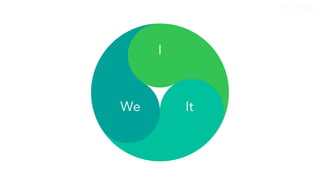Evolution Week 2 - Alignment, Feedback, Culture
- 1. Transtech Academy Evolutionary Business - Week 2
- 2. I ItWe
- 3. Aligning with another: The art of giving and receiving feedback
- 6. Johari Window Unknown Known Known Unknown Open Blind Spot Hidden Unknown Others To Me Hidden Unknown 6
- 7. Johari Window Unknown Known Known Unknown Blind Spot Hidden Others To Me Unknown Sharing Feedback 80% Open
- 8. 8 The Foundation of good feedback: self management
- 9. Victim Caretaker Persecutor Deserter When we get triggered, we take our position on the “Triangle”
- 10. Goal: Get off the “Triangle” Take one act of power Empower Others Stay in the game Give up the right to be right Victim Caretaker Persecutor Deserter
- 11. WHAT HAPPENS WHEN WE COMMUNICATE The sender Message sent Context Position Style Emotion Words used
- 12. WHAT HAPPENS WHEN WE COMMUNICATE The receiver Response Choice Meaning Feelings Meaning Personal filters Message received
- 16. 16 • Always - do a self check • Use “I” statements • Make it specific • Make it as impersonal as possible • Make it goal/action oriented • Ensure understanding • Make sure it is controllable • Tailor it to fit context/situation/person General feedback principles
- 18. Receiving feedback • Say “thank you” first • Take time if you need • “Own it” - find something to learn about and for yourself • Ok to ask clarifying questions - when you are clear and grounded
- 19. ▪ Live feedback - can be a dialog, questions, longer discussion., Most helpful for more crucial conversations ▪ Email/Slack etc. - Caution! Feedback most always should be impersonal and focused. Craft it carefully ▪ 1 x 1’s - both manager and direct report should offer feedback regularly ▪ Peer/team feedback - the holy grail! Try doing it as a team to socialize it in first. ULTIMATE GOAL: EVERYONE GIVES FEEDBACK TO EACH OTHER, ALL OF THE TIME! Understanding context
- 20. Feedback grab bag 1. Can it be a dialog instead? 2. What about feedback to my manager? To a peer? To a senior executive? 3. What about email/slack/live/etc.? 4. Is it ok to give sandwich feedback?
- 21. 1. (Ask questions/get clear/ground) 2. State the purpose • I wanted to talk with because I feel disconnected... • The project is a bit delayed... 3. State the data (what I experience/see...) • “Here is what I saw…” • “When this came in 2 weeks late…” 4. State the impact and/or inference • “My experience is...my judgment is...” • “I am frustrated…” • “This causes me stress…” 5. Come to agreement/make a suggestion/request • “ I would ask…” “So we agree..” P.D.I.A.
- 22. Vision, goals and strategy Management Processes Culture: brand, values and norms Individual Development Structure How to align a team
- 23. 5 STEPS TO AN ALIGNED TEAM 1. Why does your team exist? 2. Where are you going? What is the future that is different from today? 3. Who do you need, doing what work to get there? 4. What structure and process do you need to execute the work? 5. How will you coach your team?
- 26. Vision/Compelling Purpose/WHY • What’s your vision/comp purpose for your team? • What does the future look like? • How it will feel? • How it will operate? • Strategy and structure?
- 27. Who is going with you?
- 28. Building the right team • Given your goals, who will you need doing what? • New hires? • Shift roles and responsibilities? • What’s the right structure to support this? What is the culture you expect?
- 29. Managing individuals has two dimensions 1. The business and technical aspects of their job 2. The behaviors and cultural attributes you expect for their role, including Collective cultural attributes What is your answer for #2?
- 30. Team Agreements or Norms •What behaviors will hold and sustain your team? •What can you hold each other accountable to? •What kind of culture would you like to create?
- 31. 5 STEPS TO AN ALIGNED TEAM 1. Why does your team exist? 2. Where are you going? What is the future that is different from today? 3. Who do you need, doing what work to get there? 4. What structure and process do you need to execute the work? 5. How will you coach your team?






























